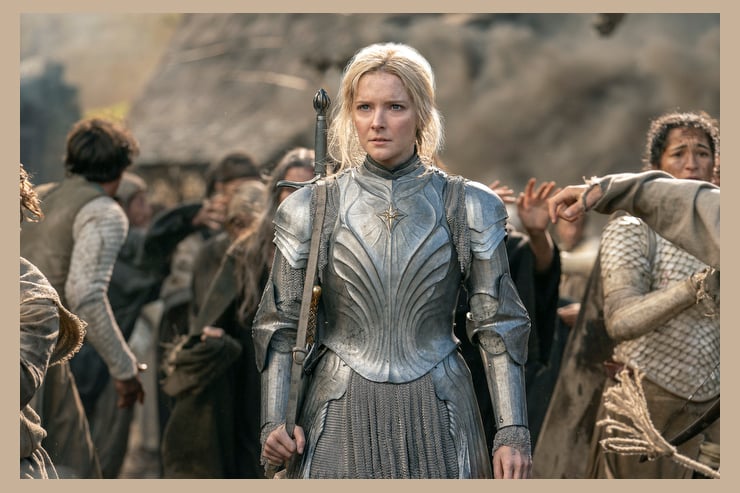The Lord of the Rings: The Rings of Power
Created and written by Patrick McKay and John D. Payne ◆ Based on the novels by J.R.R. Tolkien ◆ Produced and distributed by Amazon Studios
Something no one asked for has arrived: Amazon’s prequel television series based on the backstory of J.R.R. Tolkien’s Lord of the Rings fantasy novels. As many expected, this tremendously expensive series is dull, bereft of likeable characters and skillful storytelling, and unmoored from the European folklore and the Christian moral themes that made Tolkien’s novels classics of Western literature.
The roster of lead characters assembled by the showrunners, Patrick McKay and John Payne, makes their political leanings clear and reads like an intersectional anti-discrimination checklist. Tolkien’s fabled Númenóreans, the “Men of the West,” are ruled by a disabled black woman; Durin, patriarch of the mighty Dwarves, has a fat and boisterous black woman as his queen; and the chief of the Hobbits is an elderly black man. The casting of the ancient race of Elves appears to be the only part of the production that remained generally true to the Northern European character of the Tolkien source material, though one of the three lead elven characters is played by a Puerto Rican actor.
Meanwhile, Tolkien’s iconic Orcs, whose skin Tolkien described as “sallow” (i.e., of a grayish, greenish, or yellowish hue), are white-skinned in The Rings of Power, in shades ranging from bright albino to sunburned pink. Audiences would have to be obtuse not to see that these creative choices are animated by the view that white skin is uniquely related to history’s greatest evils.
Tolkien wrote The Lord of the Rings in the 1930s and ’40s as an epic based primarily on English mythology, and centered on that most-English of fantasy creations: the Hobbits. Tidy, polite, parochial, and insular, the land of the Shire resembles the Cotswolds, and Tolkien has the Hobbits living like 19th-century English country gentlemen. Yet, in The Rings of Power, the Harfoot Hobbits are depicted as living like a New Guinea tribe: itinerant hut-dwellers with twigs in their hair and dirt on their faces.
The driving themes of sin, temptation, and struggle against evil personified—which were central to Tolkien’s original series and informed by his Catholic faith—seem to be weak or missing in this production. For example, in Tolkien’s novels and Peter Jackson’s faithful 2001–to–2003 film adaptations, the wizard Gandalf the Grey is an analogue of an Old Testament angel or prophet. He undergoes a series of harrowing experiences—betrayal by his superior and combat with a demon deep within the earth—through which he is reborn as Gandalf the White. This dark night of the soul so transforms Gandalf that, as he reunites with his companions in a rain of heavenly light, he realizes he has forgotten his mortal name. “Gandalf? Yes … that was what they used to call me,” he remarks.
In The Rings of Power, however, Gandalf goes through another kind of transformation, falling from the sky naked and impacting the ground in a flaming crater. He remains so disoriented and feeble that he cannot speak and must be led around in a state of infantile confusion, like Lennie from John Steinbeck’s Of Mice and Men. A heavenly messenger, this is not.
Other patriarchal heroes of Tolkien’s universe are silly and feckless in The Rings of Power. The dwarven king Durin and the elven price Elrond are introduced in a bitter feud; after some suspense, Durin reveals with tears rolling down his cheeks that he’s upset that Elrond missed his wedding. This ridiculous scene ends with the dwarven queen resolving the quarrel by chiding the men for their emotional immaturity.
Meanwhile, the central female character of the series, Galadriel, is portrayed improbably as a harsh warrior of incredible skill, single-handedly besting mighty trolls and whipping male soldiers into shape. Gone is the majestic, ethereal femininity and mystery of the Lady Galadriel of the novels, portrayed regally by Cate Blanchett in Jackson’s films. Morfydd Clark’s Galadriel is insufferably macho in her demeanor and has been derided by online commentators as a “girlboss” and a “Mary Sue”—meaning an unrealistically powerful female character.
At the end of the first season, McKay and Payne appear to be shaping Galadriel’s character arc toward a romance with a disguised version of the Satan figure of Tolkien’s books, Sauron. Perhaps they think this doomed romance will draw in the female demographic that appreciated the bad-boy sex appeal of Twilight and Fifty Shades of Grey.
It is not hard to imagine what Tolkien, who loathed what Walt Disney did with European folklore, would say about Rings of Power. It is harder to imagine why Amazon decided to spend $1 billion to turn Tolkien’s source material into five seasons of fan fiction. Just as a conquering army defaces the monuments of its defeated foes, America’s woke film industry has seized the opportunity to have its way with the mythology of the Men of the West.

Leave a Reply